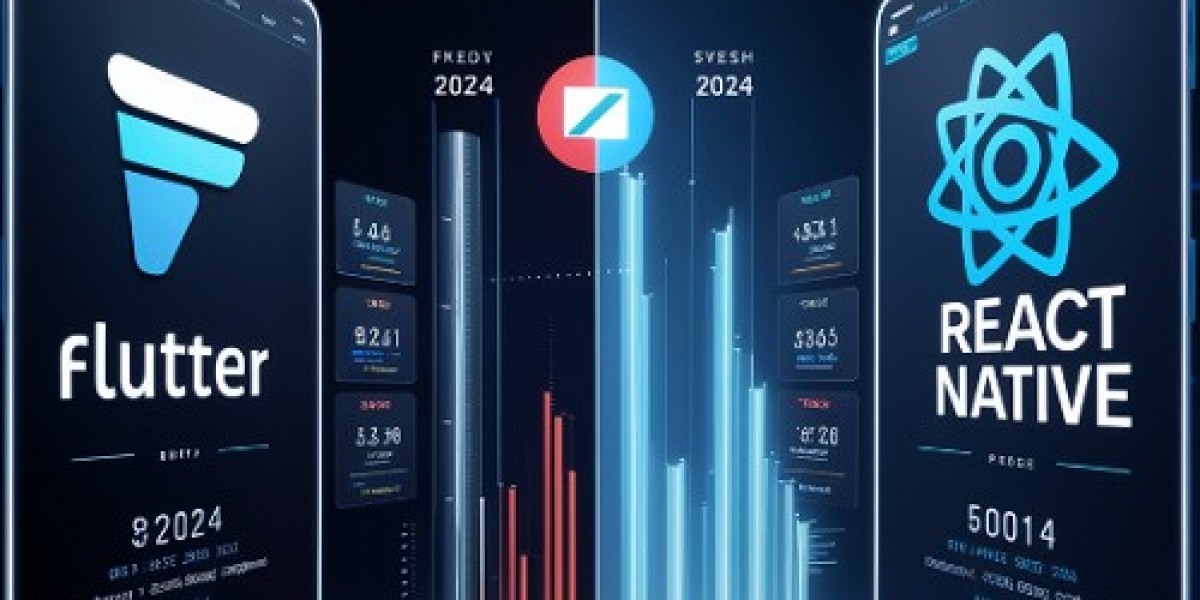The debate between Flutter and React Native is heating up in the mobile app development world. As 2024 approaches, picking the right framework for your app is more important than ever. This article will look at the main differences between Flutter and React Native. We'll also discuss their strengths and what to think about when choosing the best one for your project in 2024.
Key Takeaways
- Flutter and React Native are both strong frameworks for making apps that work on different platforms. They have their own strengths and weaknesses.
- When deciding between Flutter and React Native, consider things like performance, your team's experience, the look and feel you want, community support, and what's coming next in tech.
- The choice between Flutter and React Native in 2024 will depend on what your app needs and what your team likes.
- Both frameworks have great benefits. The decision should be made after carefully thinking about your project's needs and your goals.
- New technologies like Wasm and AI-powered tools might change how we make cross-platform apps in the future.

Introduction to Cross-Platform Mobile Development
The mobile app market has grown fast in recent years. People use their smartphones and tablets for many tasks. This growth has led to cross-platform mobile development. It lets developers make apps that work on many platforms, like iOS and Android, without needing different codes.
The Rise of Mobile Applications
Mobile apps are now a big part of our lives. They change how we talk, work, and get information. We use them for everything from productivity tools to social media and games.
The Need for Cross-Platform Solutions
Developers now face the challenge of making apps that work on many platforms. Cross-platform mobile development is a key solution. It lets developers use one codebase for apps on different operating systems. This cuts down on development time and costs and gives users a consistent experience.
Frameworks like Flutter and React Native have made cross-platform development more popular. These frameworks help developers make apps that look great and work well on any platform. This means users get a smooth and enjoyable experience.
The mobile app market is always changing. So, the need for cross-platform solutions that work well on many platforms is growing. Powerful frameworks have made it easier for developers to create apps that reach more people. This has started a new era in mobile app development.
What is Flutter?
Flutter is a free, open-source framework made by Google. It lets developers make apps for mobile, web, and desktop with just one set of code. This makes it a top pick for developers around the world.
Overview of Flutter
Flutter uses the Dart language, also from Google. Dart is modern and object-oriented, turning into native code for fast performance. Flutter's design ensures a great user experience across platforms, appealing to businesses and developers.
Flutter's Architecture and Features
Flutter's core is the widget tree, where every UI part is a widget. This lets developers build complex interfaces by combining these widgets. Flutter offers many built-in widgets and lets you create your own, giving you control over your app's look.
Key features of Flutter include:
- Fast performance thanks to Dart and the Skia graphics engine
- A wide range of pre-built widgets, including Material Design and Cupertino styles
- Custom widget creation and Dart language benefits
- Hot reload for quick code updates
- Strong testing and debugging tools for app quality
Flutter stands out with its strong architecture, many features, and growing community. It's a strong competitor in cross-platform development, rivaling React Native.
What is React Native?
React Native is a popular open-source framework for making mobile apps that work on both Android and iOS. It's made by Facebook and lets developers use the React JavaScript library to build apps. Unlike other methods, React Native turns React components into native UI elements directly.
React Native is built on React, a powerful JavaScript library for making user interfaces. Developers can use their React skills to make mobile apps that look and work like native apps. They don't have to write separate code for iOS and Android.
React Native makes apps run smoothly and look great. It does this by using native components. This means the app's interface is smooth, fast, and looks good, just like a native app. It does this by connecting JavaScript with native APIs in a new way.
Feature | Description |
Native UI Components | React Native has pre-made UI components that match their native versions. This makes the app look and work like a native app. |
Cross-Platform Compatibility | With one codebase, developers can make apps for both iOS and Android. This saves time and money on development and upkeep. |
Live Reloading | React Native's live reloading lets developers see changes in the app instantly. They don't have to rebuild the whole app. |
Performance | React Native is fast and efficient. It's a good choice for making high-performance mobile apps. |
Using what is react native, developers can make apps that look good, work well, and run smoothly on many platforms. React's design and access to native features make React Native a strong choice for making apps for both Android and iOS.
For more info: https://youtube.com/watch?v=X8ipUgXH6jw
Flutter vs React Native: Performance Comparison
Choosing the right framework for cross-platform mobile apps is key. Flutter and React Native both have their pros and cons in terms of performance. Let's look at how these two frameworks stack up against each other.

Flutter's Performance Advantages
Flutter is known for its top-notch performance. It uses the Dart language and a fast rendering engine called Skia. This combo makes animations smooth, even on older devices. Plus, its reactive UI and native code compilation boost its performance even more.
React Native's Performance Strengths
React Native uses JavaScript and the React.js library for building apps. It doesn't quite match Flutter's performance, but it's getting better. By improving how JavaScript talks to native parts, React Native offers a smooth experience in many cases.
The performance of Flutter and React Native can vary. It depends on the app's complexity, the features used, and the device hardware. Developers should think about their project's needs and pick the best framework.
"The choice between Flutter and React Native often comes down to the specific needs of your project and the expertise of your development team."
In summary, Flutter leads in performance thanks to its native rendering and Dart's benefits. But React Native has also gotten better and can offer great performance too. Choosing between Flutter and React Native should be based on your project's needs and each framework's strengths.
Flutter vs React Native: Development Experience
Choosing between Flutter and React Native affects how efficient and productive the project and developers are. Flutter stands out with its developer-friendly ecosystem. It offers tools and resources that make development easier.
Flutter's Developer-Friendly Ecosystem
Flutter has many features that meet developers' needs. It has a great flutter development experience with tools, libraries, and utilities. These make development simpler. The Dart language and Flutter SDK create a cohesive environment for developers to easily bring their ideas to life.
- Comprehensive documentation: Flutter's documentation is clear, thorough, and easy to access. This helps developers get started quickly and find the info they need.
- Intuitive tooling: The Flutter toolchain, with Android Studio and Visual Studio Code integrations, offers a smooth development experience. It includes hot reload, code analysis, and debugging tools.
- Vibrant community: The Flutter community is growing fast. It has many resources, tutorials, and open-source libraries. This helps with collaboration, sharing knowledge, and improving the framework.
The react native development experience also has great tools and resources. But, its ecosystem might not be as unified as Flutter's. Developers might have to use more libraries and tools, which can add complexity.
Feature | Flutter | React Native |
Tooling | Comprehensive and integrated | Diverse, but may require more setup |
Documentation | Extensive and user-friendly | Comprehensive, but can be more scattered |
Community Support | Growing rapidly | Mature and well-established |
The choice between Flutter and React Native depends on the project's needs, the team's familiarity with the frameworks, and how integrated and cohesive the development process needs to be.
Flutter vs React Native: UI and Design
Choosing between Flutter and React Native can greatly affect how your app looks and works. Both frameworks have their own strengths for UI and design. They meet the needs of developers and designers in different ways.
Flutter's Customizable UI Components
Flutter uses Dart and offers a flexible UI toolkit. Flutter UI and design lets developers make many custom UI components. This means designers can create unique and eye-catching user experiences that match their brand.
React Native's Seamless Integration with Native Components
React Native UI and design works well with native UI components of iOS or Android. This makes the app look and feel more like a native app. Flutter vs React Native UI design is about choosing between customizing and fitting in with the platform.
Choosing between Flutter and React Native depends on your project's needs, design goals, and how much customization you want. The right choice will make your mobile app look great and easy to use.
"The user interface is the face of your app, and it's crucial to get it right."
Flutter vs React Native
When looking at cross-platform mobile development, Flutter and React Native stand out. They have different strengths and appeal to various developers. Let's compare them to help you choose the right one for your project.
Architecture and Rendering Engines
Flutter has its own engine, Skia, for rendering. This gives a smooth and native-like experience. React Native uses the platform's native UI, making it blend well with the device's look and feel.
Performance and Efficiency
Flutter is fast, thanks to its Dart and Skia engine. It's great for apps with lots of graphics. React Native is better for apps with lots of text, thanks to its native UI.
Development Experience
Flutter has a great ecosystem for developers, with lots of tools and widgets. React Native also has a big community but might need more setup for certain projects.
UI and Design
Flutter lets developers create unique and beautiful interfaces with its customizable UI and design tools. React Native offers a more familiar look and feel by using native UI components.
Choosing between Flutter and React Native depends on your project's needs, your team's preferences, and what you want the app to feel like. Both frameworks are strong for mobile app development. Pick the one that best fits your project.
Community and Ecosystem Support
When comparing the flutter community and the react native ecosystem, both have their own strengths. The flutter community is growing fast, offering more libraries, tools, and resources for developers. This makes it simpler for developers to solve problems and create strong mobile apps.
The react native ecosystem is more developed, with lots of third-party tools and plugins. These tools help developers add features and functions to their apps quickly. This cuts down on the time and work needed for development.









